
© 2010-2023 by Fine Arts of the Southwest, Inc. All rights reserved.
Unauthorized reproduction or use is strictly prohibited by law.
We are attributing this remarkable buckle to the internationally-renowned Navajo silversmith and educator, Ambrose Roanhorse (1904-1982). It has a strikingly modernist, yet completely classic design sensibility and a formidable technical virtuosity and command of traditional Navajo jewelry-making methods. This is all completely consistent with the beautiful refined appearance and extremely high technical level of achievement which has always been associated with Roanhorse’s exceptional silverwork. This is the reason why he remains the only Navajo silversmith in history to have ever received the honorific title of “Beshlakai Nataani” or “Leading silversmith of the Navajo Nation”, a title bestowed on him by the Navajo Tribal authority. In 1955, the French Government also officially recognized Roanhorse’s superior achievements by awarding him their prestigious “Palmes Academique” award as seen below.
The creation of this marvelous buckle involves two of the most famous and accomplished characters in the 20th Century Southwest and one of its most renowned institutions. The first character is the aforementioned greatest Navajo silversmith of his time, Ambrose Roanhorse (1904-1982), and the second character is the renowned Austrian-born art curator and teacher, Count Rene d’Harnoncourt (1901-1968), whom the U.S. Government had recruited to be Director of the Indian arts and Crafts Board (IACB), a New Deal agency created to revive traditional Native American arts and crafts. d’Harnoncourt, in turn, promptly recruited Ambrose Roanhorse as his advisor and co-manager. The revered institution involved ihere s The Santa Fe Indian school, where Ambrose Roanhorse served
as director and jewelry instructor during this time period and through whose halls over the decades passed many of the greatest Native American artists of their time, from Roanorse himself to Fred Kabotie, Allan Houser, Pablita Velarde and a great many others.
“It sure feel good when you wear hand-made jewelry. If they use machine jewelry, by golly, one these days 20 years from now goin’ to have big sandstorms-10 years, 8 years, maybe 5 years. That’s the way I feel.”
-Ambrose Roanhorse, 1936
Quotation from Billie Hougart, “The Little Book of Marks
on Southwestern Silver”, TBR International, 2011
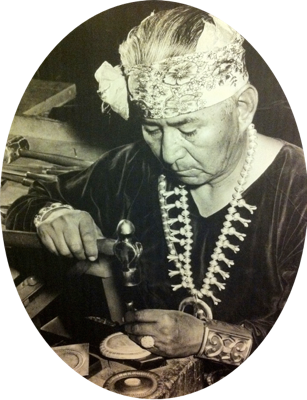
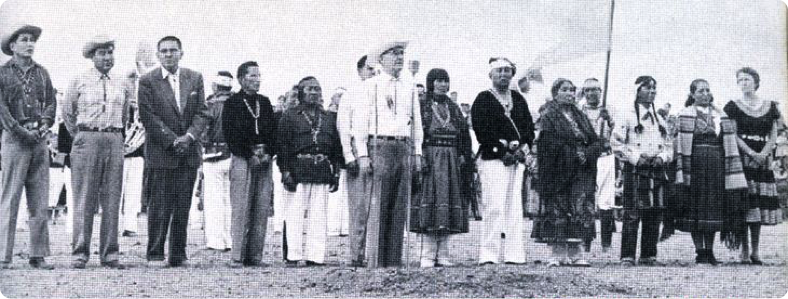
In August 1955, twelve Native American artists including Ambrose Roanhorse were awarded the prestigious "Palmes Academique", a French civilian award for extraordinary achievement. The awards ceremony took place in Gallup, New Mexico. Ambrose Roanhorse is pictured at sixth from right in the photo above.
Photo source and © Heard Museum, Phoenix, Arizona
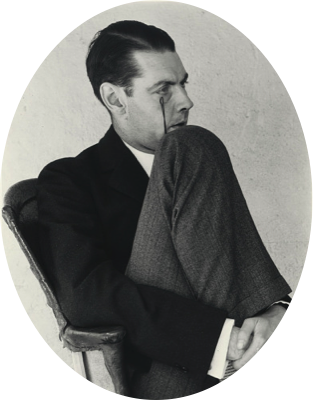
At left, Ambrose Roanhorse c. 1940. At right, Rene d'Harnancourt, c. 1930.
Right photo source and © National Portrait Gallery, Smithsonian Insitution.
In 1938, d’Harnoncourt and Roanhorse initiated the "U.S. Navajo" and "U.S. Zuni" inspections program designed to create, ensure and enforce the highest possible standards of quality in traditional craftsmanship and materials used
in making Native American jewelry sold across the Navajo, Zuni and other Indian reservations. Member organizations included various individual trading posts, Indian schools such as those in Santa Fe, Fort Wingate and other arts and crafts guilds. Each member organization received a specific numeric designation and only jewelry produced to the IACB’S exacting standards would be officially approved for sale and marked as such with the appropriate “U.S. Navajo” or "U.S. Zuni" numeric designation. Ambrose Roanhorse personally made all the various "U.S. Navajo" and "U.S. Zuni" stamps himself and he also personally applied the appropriately numbered stamps to the pieces of jewelry only after
he had personally inspected them and approved of their superior quality.
Since the IACB program lasted only four years, the number of officially-approved and stamped “U.S. Navajo” pieces
is extremely small, so they are quite rare and some designations such as this one “U.S. NAVAJO 60” the mark assigned to The Santa Fe Indian School are among the rarest. And even though the various “U.S. Navajo”-designated pieces are all made to a consistently high standard of quality, the extraordinary artistry and craftsmanship of this particular buckle puts it on an even higher level than most of the other U.S. Navajo marked pieces we have seen, which is the most important factor in our strong attribution of the piece’s maker as actually being Ambrose Roanhorse himself.
The buckle is a triumph of beautiful design and exacting craftsmanship; it has perfect proportions and it is gracefully domed or repousseed giving it a unique profile and it is sparingly and perfectly decorated with refined and elegant stamp work decoration around the center opening and the scalloped outside perimeter. The wide expanse of lustrous polished silver which looks good enough to eat, punctuated by the elegant stamp work borders is immensely appealing and satisfying. There is a superb handwrought sculptural nature to this buckle almost as if it were hand carved from
a solid block of silver. It looks fairly simple, but in reality it is anything but; the amount of control and technique required to do this is astounding. Only a supreme master silversmith could have such expression and restraint.
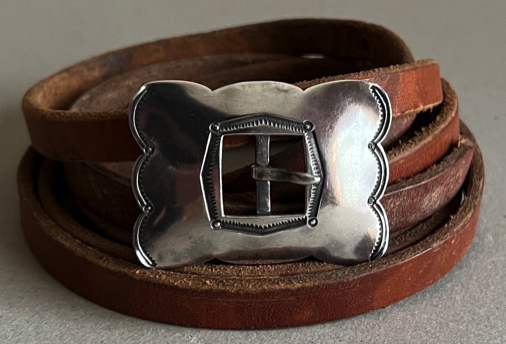
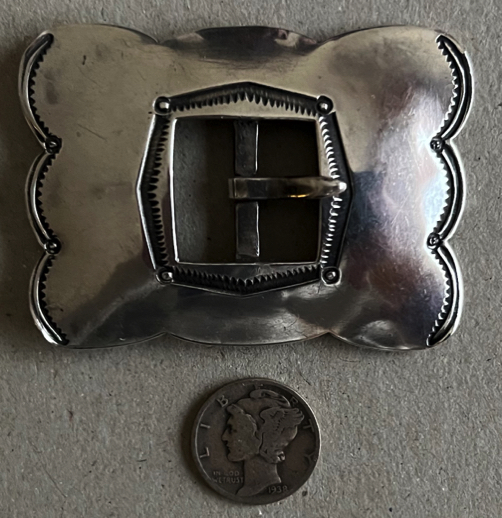
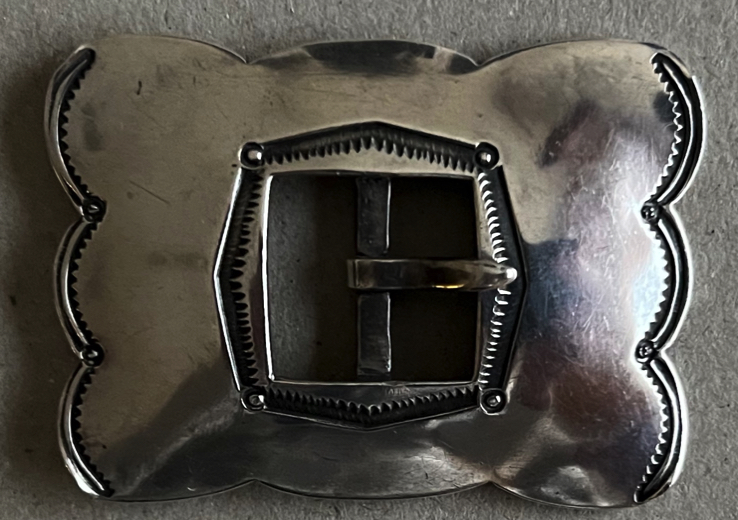
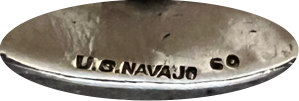
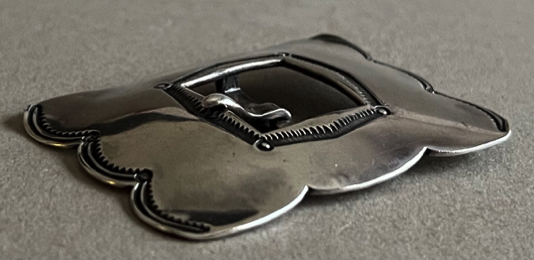
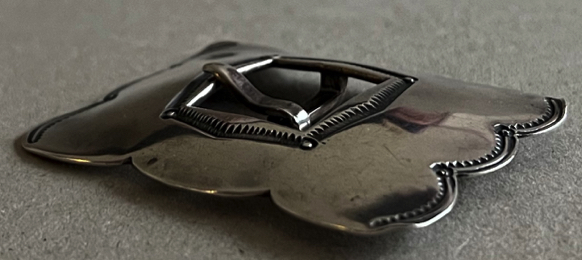
The buckle measures a fairly diminutive 2 1/8" in width and is 1 5/8" in height. It weighs a very comfortable 24 grams
or 7/8 ounce and it is in excellent original condition with some degree of age-appropriate wear and a fine rich patina from age and use. The buckle will accept a belt strap of up to 5/8" in width. The buckle is properly and finely hallmarked “U.S. NAVAJO 60” by Ambrose Roanhorse on the back.
Exceptional artistry, extraordinary craftsmanship and unique American and Southwestern history abound here.
This rare buckle packs an awful lot of greatness into a relatively small package. Wear it on its own, wear it on a great Navajo concho belt or don’t wear it at all and just admire it. It’s great any and every way you look at it.
SOLD
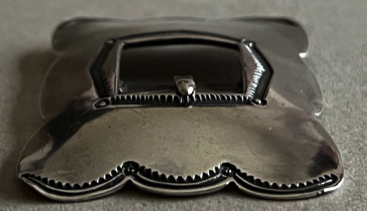
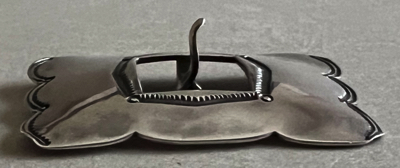
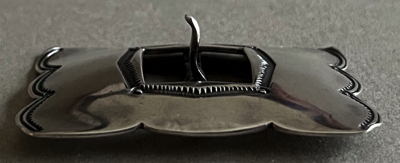
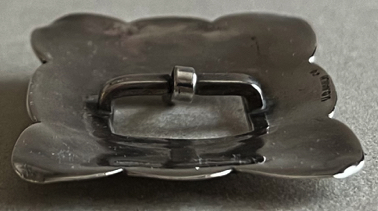
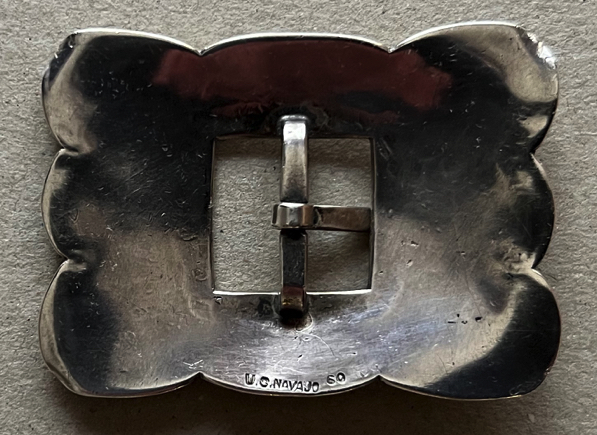
An extremely rare “U.S. NAVAJO 60” silver buckle
of outstanding quality attributed to Ambrose Roanhorse, Santa Fe Indian School, NM,1938-1942
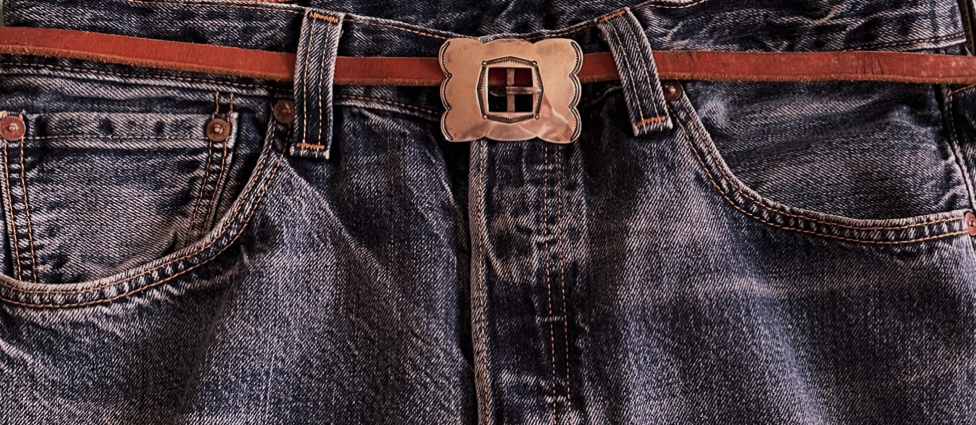
We do not yet have a belt made for this buckle, but this simulation photo should give you an approximation of its size and scale and how it would look on a belt.